
We independently review everything we recommend. When you buy through our links, we may earn a commission.
Bigfoot reviewer Wide Foot Jarrett runs in the shoes, then gives you the gospel truth
2E width
Everything from daily trainer to trail (listed in alphabetical order by brand)
NOTE: This is an evergreen list (last updated 2/5/2024). For the best plated and race day shoes for wide foot runners, check out our Best Plated Shoes for Wide Foot Runners list.
PSA: This is Jarrett’s wide foot running shoe roundup, and this is a safe space. As all wide foot runners know, we’ve been shunned for far too long. There are dozens of us, dammit! So this is a place where my fellow wide fam can view all the good options that work for us folk who can’t squish into those “normal” width shoes.
Now, this is technically not a “Best Of” list (although my favorite shoes are indeed in here). Instead, this is a list of almost every wide shoe that I’ve run in that’s currently available. I’ll give you the good, the bad, and everything in-between. Some shoes will have links to my full review, and others will offer summaries of shoes I have worn but received after others on our team reviewed them (it turns out very few companies care about doing pre-production runs of wide shoes).
As any runner with wide foot problems knows, the list of companies who cater to us is pretty brief. You’ll also notice that the following list is New Balance-heavy, as they consistently offer the most diverse options in the wide segment (for that, we thank you, New Balance).
We’ll keep updating this list throughout the year (organized alphabetically, btw), so check back for new additions from time to time. Should you have any questions or shoe requests, leave a comment below or hit me up on the gram!
Race day
7.6 oz (215 g) for a US M9
39.5 mm in heel, 33 mm in forefoot (6 mm drop)
Adidas has one of the hottest shoes on the market with the Adizero Adios Pro 3. It has been in a ton of podiums and even swept the top 4 men’s shoes at the 2023 Boston Marathon. Was there any doubt I’d find a way to get these on my feet and see how they work out for the #WideFootFam?
The Adios Pro 3 has a Celermesh upper that is practically see-through. It doesn’t have much stretch, however the Adidas 3 stripes on the midfoot are printed on and aren’t constricting overlays. I think the toe box is accommodating enough to wear. The midfoot feels secure and snug. It’s tight, but doesn’t hurt. I also don’t think there’s much arch support. My foot hangs over both sides in the midfoot. The good news is the platform doesn’t curl up and dig in anywhere (a problem I noticed in the Hoka Rocket X 2). I also find the shoe feels way better when running compared to standing or walking.
Hands down the most frustrating part of the shoe is the lacing. It takes 2-3 times finagling with it to get a good lockdown without hurting. It’s also not easy to pull the laces tighter. This seems to be an issue others have, so hopefully it gets addressed. Also, I had heel slip and Achilles rubbing on a few of my runs. Some ended fine, while others ended with pretty gnarly blisters. The rubbing probably goes along with the lacing lockdown problem.
Adidas uses a Continental rubber outsole on the Adios Pro 3. The grip is awesome. It’s sticky and helps my confidence while trying to take turns quickly.
Apparently Adidas widened the shoe platform for additional stability, which explains why it’s a viable race day option for us. The midsole is composed of Lightstrike Pro and Energyrods (instead of a carbon plate, these are rods which almost look like a skeleton foot).
The Adios Pro 3 is highly cushioned and bouncy, but if you’re used to the Prime X, it’s firmer than that which causes the Pro 3 to feel even faster. I took the Adios Pro 3 out for a handful of different run types. During short 30 second max effort repeats I felt like I was flying as the turnover is so quick and smooth.
On a 12 mile long run I felt like I was comfortably cruising at a 7:45 minute mile pace, although it ended with the worst Achilles blister. I also decided to use them at the Baltimore 10 miler where I went way too fast out of the gate because of how good they felt. A super hot morning got the best of me and I eventually bonked, but when the day is right, the shoes are amazingly fast.
I’m really digging the Adidas Adizero Adios Pro 3. They are a top tier super shoe and to be able to wear them on races at half marathon distance or less is a big win for the wide-footers out there. Thin socks are important as the midfoot is snug, but not debilitating, and hopefully the heel rub issue is a personal one. Keep the heat (not literally) coming, Adidas, and please don’t narrow anything!
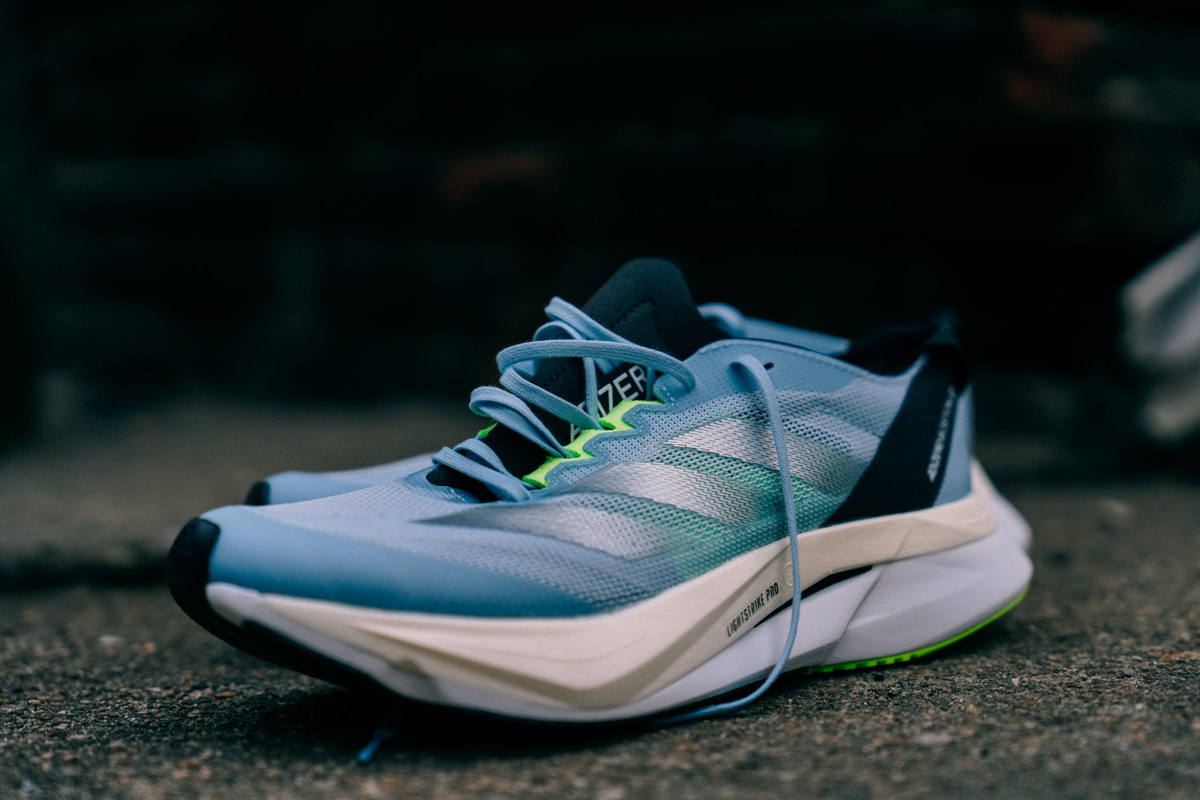
$160
Daily trainer, uptempo, budget race day
9.9 oz (280 g) for. US M10.5 2E
37 mm in heel, 30.5 mm in forefoot (6.5 mm drop)
Fam, it’s a wide Adidas shoe! The Boston 12 is a daily trainer that leans more towards performance with the combination of Lightstrike Pro, Lightstrike 2.0, and glass-fiber infused Energyrods 2.0 (not as premium as a carbon plate). It took a few extra weeks for the wide version to be released, but I can safely say it was worth the wait.
The lightweight mesh upper is pretty standard. It wraps the foot nicely, and isn’t suffocating. I think the wide fit is actually pretty nice! I don’t have any pain in the midfoot, nor do I have any squeezing or blisters from the forefoot. My arches aren’t hanging over with no support. Adidas actually widened the forefoot from the Boston 11 and the heel is wider than the Adios Pro 3 so you don’t feel like you’re running on a tightrope.
I noticed that my 10.5 2E run a touch long, although heel lock lacing takes care of the extra length problem. The lacing system is eh, but I do think it’s better and easier to work with than the Pro 3. As for the heel counter, it’s super thin and just about the same as the Pro 3 and Prime X Strung. I can’t explain what is different, but I never experienced any Achilles rubbing and blisters. If I could have this upper on the Pro 3 and Prime X, oh boy would I be a happy camper.
Lightstrike Pro and Lightstrike 2.0 work together to provide a light and stable ride that feels semi-firm. By having Energyrods, you get some propulsion. It’s not as snappy and aggressive as the carbon plate Energyrods in the Pro 3.
How does all this midsole technology feel? Well, it’s not mushy or as bouncy as the Pro 3. I get more ground feel and a bit firmer of a ride. At a slower pace, it feels like your standard daily trainer, but pick the speed up and it is able to transform into a much faster shoe.
Basically, the Boston 12 reminds me of the Pro 3’s little brother, which is why I couldn’t stop comparing the two this whole time. The Boston 12 a peppy daily trainer, but can even be used as a race day option for a fraction of the price. I truly hope Adidas makes more shoes in wide because their running line is killing it!
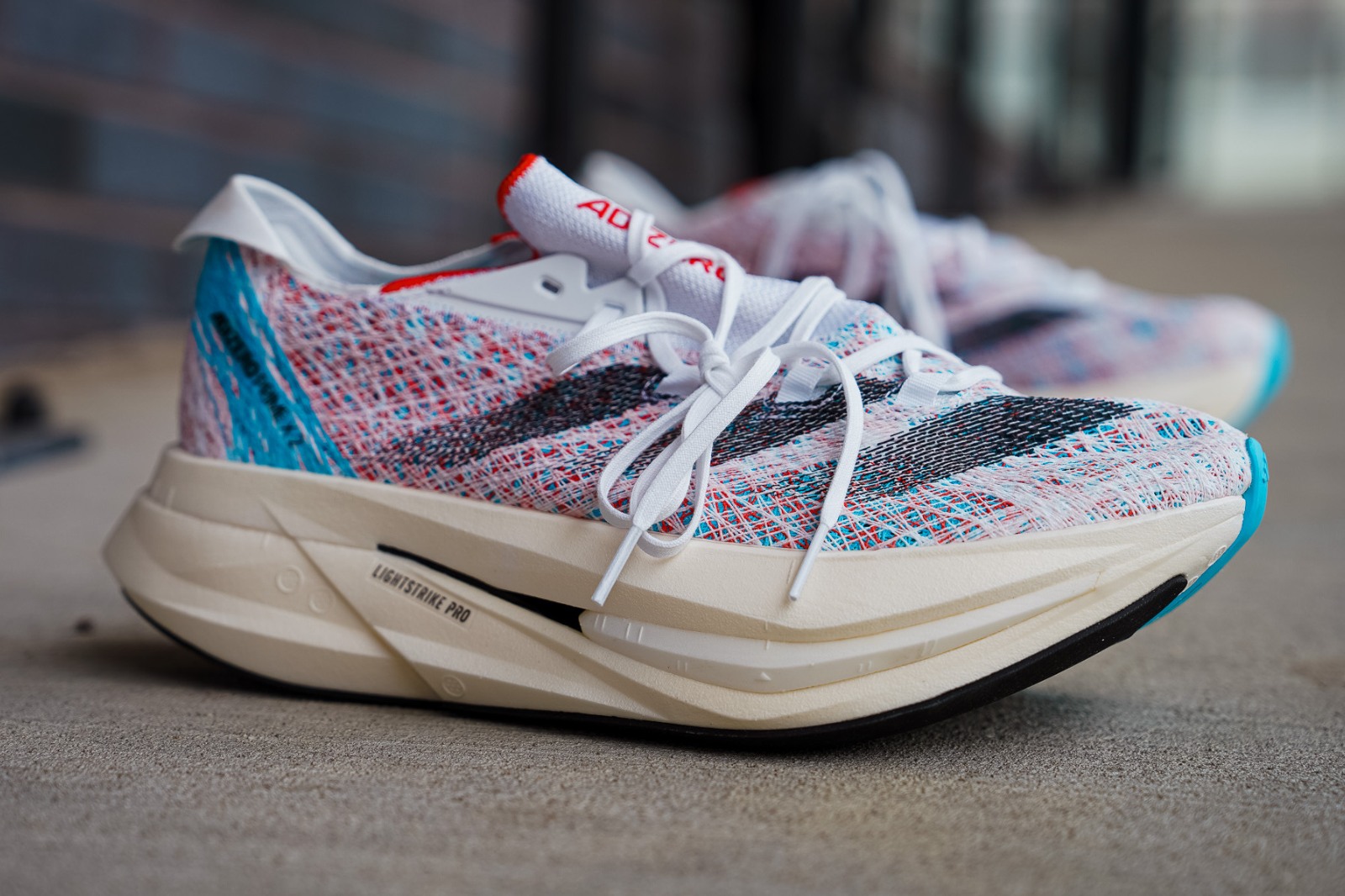
$300
Daily trainer, long run, marathon
11.7 oz. (331 g) for a US M10.5 (standard width)
50 mm in heel, 43.5 mm in forefoot (6.5 mm drop)
There is no denying the Prime X 2 Strung has been on the receiving end of strong opinions. The first version was so loved and there were such high expectations going in. It was almost shocking to hear the 2 oz. weight gain. I guess it’s a good thing I received this after everyone else finished their reviews, so I was able to tame my hype and go in with realistic expectations.
The strung upper is similar to the first Prime X, but this time the tongue is now a stretchy knit. I find the upper to feel snug and a little tight on my midfoot, but it doesn’t hurt or concern me while out running. Even though my heel slips a little, I haven’t had any problems with blisters on my Achilles like I did with the first Prime X. I also think the shoe runs a touch long.
Adidas took v2 one step further by adding a second carbon plate to the mix and a third layer of Lightstrike Pro. The third layer is a smaller puck located in the forefoot between the 2 carbon plates. The point is to provide even more pop in your step and act as a spring.
The outsole is a grippy continental rubber and the base has been widened to help to make the Prime X 2 way more stable and supportive. I don’t feel like I’m running on a tightrope nor do I get nervous if I heel strike.
I used the Prime X 2 for the entire assortment of runs that Coach gave me. On my easy day and recovery runs I felt like I wasn’t exerting much energy. I bounced along with ease and felt good at slower paces. My Wednesday workouts were another story. It felt hard to pick up the pace and that’s where I didn’t love the heavier shoes. The longest run I did in them was 17 miles and I was back to enjoying the Prime X 2 to cruise in. My legs didn’t feel trashed by the end of the run nor the next day.
I know the team was disappointed by the Prime X 2, but I legitimately have been having a really good time in them. I may be able to get a bit more out of the midsole because I am bigger and can compress the foam more. Also, as much as I dislike the weight gain, I’m so used to my wide shoes being on the heavier side. The Prime X 2 feel awesome underfoot and are a pleasure to do easy and long runs in. My legs don’t feel beat up, and I’ll take that any day. I think the Prime X 2 is a really good daily trainer, so long as you can get over the $300 price tag.

$250
Race day
8 oz. (226 g) for a US M10.5 (standard width)
39 mm in heel, 31 mm in forefoot (8 mm drop)
When I saw the updates to the Metaspeed series, I knew I had to try it out, even if it was a standard width. I loved the Metaspeed Sky for running fast workouts and races. Hell, I even PR’ed my 5k in them and went sub 20 minutes for the first time.
The Metaspeed Edge+ is for the cadence-runner who increases their speed by increasing the number of strides (as opposed to the stride-runner who takes longer steps and may like the Sky+ more). Asics increased the drop to 8mm, added 16% more midsole foam for more cushion and bounce, and moved the carbon plate lower to the ground.
The upper is very similar to the prior Metaspeed series with the polyester jacquard upper, super thin tongue, and lightly padded heel collar. I still have to play with the tongue to make sure it doesn’t fold over itself when putting on the shoes. The laces are ribbed and hold well.
Asics fixed the length issue, and while I had to size up to an 11 in the original Metaspeed Sky, I went with a 10.5 in the Metaspeed Edge+ and the length is perfect. I find the toe box to be a little tight, just like the Metaspeed Sky, and the midfoot is snug. I’m able to make the Edge+ work because the midfoot logo is sublimated and lacks any harsh overlays. The biggest problem I have with the upper is that I get some heel slip unless I heel lock lace tight. I’ve had to retie my shoes at the beginning of a run to get a good secure lock down.
The midsole gets the FlyteFoam Blast Turbo treatment. This new midsole is supposed to be more cushioned and give a more reactive bounce. The carbon plate was moved towards the bottom of the shoe to help make the ride feel a little less harsh and there is a noticeable toe spring for a smooth transition. The Edge+ is made for speed and doesn’t feel as good when going at an easier pace. I also think people who heel strike may find it to be unstable as the heel is more narrow than the forefoot.
ASICSGRIP outsole rubber mostly in the forefoot. If you tore up the original Metaspeeds in the heel, you’re probably going to have the same issue. If you found it to be very loud, you’re probably going to have the same issue. Otherwise, the forefoot grip works very well.
My first run in the Edge+ was for the Falmouth Road Race. I was a little nervous running in a new shoe for the first time, but they worked great. I had no pain or blisters, and besides it being stupid hot, my feet were happy. My speed workouts have also been extremely fun. The Edge+ feel so fast when pushing and they have a snappy pop that I don’t get in some of the more cushioned and softer plated shoes. For me, there’s no doubt that the Metaspeed Edge+ is a top contender on race day.
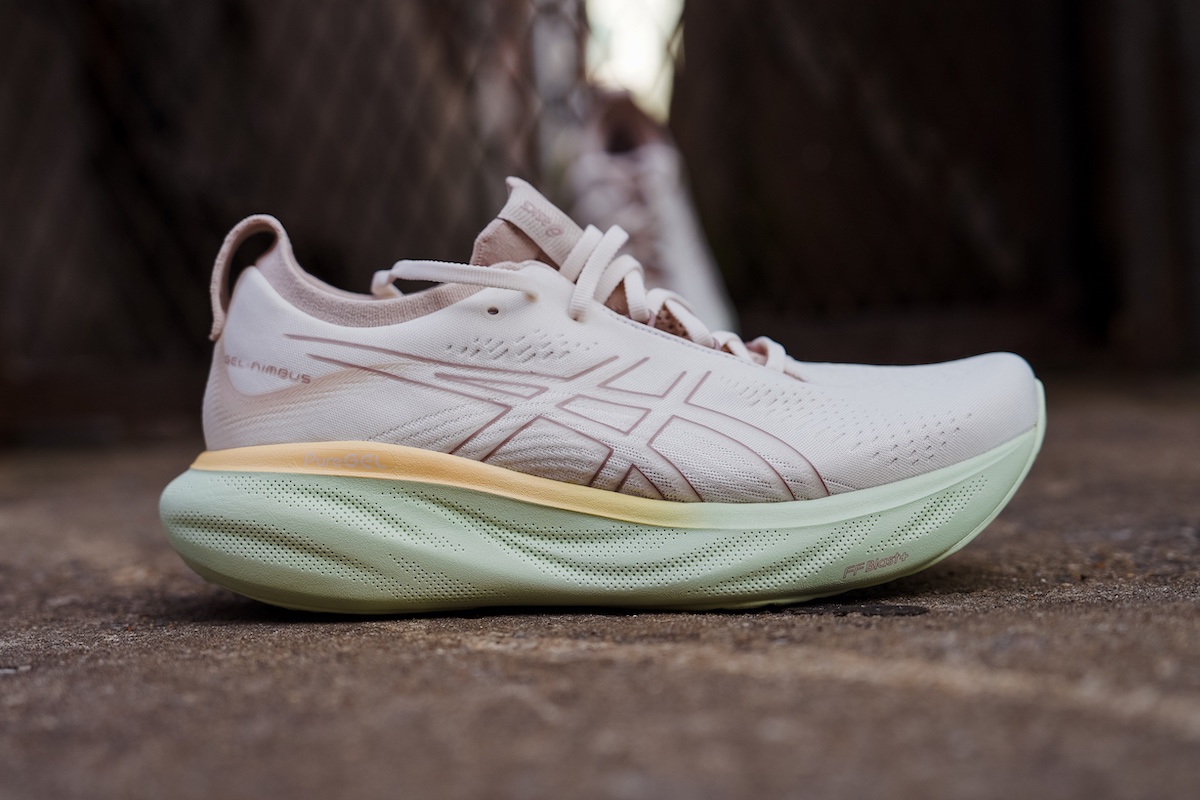
$160
Daily trainer
11.2 oz. (317 g) for a US M10.5 2E
41.5 mm in heel, 33.5 mm in forefoot (8 mm drop)
It’s safe to say the Nimbus has evolved from a boring and old school option to a top choice in the cushioned daily trainer world. The new Gel-Nimbus 25 received a top-down refresh in the best kind of way. The change is the brand new FF Blast+ Eco with an increased stack height of 5+ mm.
FF Blast+ Eco is similar to FF Blast+, but made with 20% bio-based materials, so it’s better for the world. With the extra midsole height added, the Gel-Nimbus 25 has moved into the max cushioned category, and it fits right in. This version does feel softer than the last, and while running, it has a very nice underfoot feel. I think the ride is more on the softer and squishy side, as opposed to softer and bouncy.
When compared to the Gel-Nimbus 24 2E, my Nimbus 25 2E does feel more spacious in both the midfoot and forefoot. Some may not find it on the super wide side, but I have had zero issues with fit on my pair and have put in some longer runs to make sure it still felt good after more time on foot.
The knit upper is really nice and does the job with a secure lockdown. After having my Achilles destroyed by some other thin heel collar shoes recently, I love the luxurious comfort of the Nimbus 25 heel collar padding. I can’t comprehend why companies keep trying to change this. It works. It doesn’t cause any slipping. There are no blisters. It’s what we want! As for the tongue, it’s the same extremely stretchy tongue as in the Nimbus 24, but slightly shorter. I still think it’s weird, but haven’t had any real issues with it.
Lastly, I really like how the shoe looks aesthetically. My wide all-black colorway is pretty boring and standard for us wide-footers, but I look at the tooling of the midsole and I see clouds and feel comforted. On the other hand, I look at the Novablast tooling with the sharp edges and flat surfaces and my brain thinks aggressive. The Asics designers did a great job here.
I wouldn’t use the Nimbus 25 for faster miles, as I struggled to pick up the pace. It almost feels like the shoe has one or two gears. However, those two gears are great and this shoe shines as a daily trainer on the easy miles (no matter the distance). I really like how the Nimbus has evolved, and as cliche as it sounds, I think the 25th version is the best yet.

$150
Daily trainer, neutral
11 oz (311 g) for a US M10.5 2E
39 mm in heel, 33 mm in forefoot (6 mm drop)
The Brooks Ghost Max is a brand new daily trainer that is a spinoff of the classic Ghost. Brooks went from a 35/23 mm Ghost 15 to 39/33 mm, which explains why they are adding Max to the name. I have to get it out of the way by saying the Ghost Max is my favorite Brooks wide shoe I have ever run in. It’s a killer shoe and Brooks is onto something with the first version.
I enjoyed the plush mesh upper with a really nice heel collar and padded tongue. It holds my foot in place well and there are no pressure points or heel slip going on. I think the wide fit is pretty nice, as I have room in both the forefoot and midfoot with no uncomfortable pressure. For those who need even more space, I wouldn’t say it’s super wide, but it is comfortable enough for me to put in the miles with no complaints at all. 11 oz for a daily trainer keeps it in the middle of the wide shoe weight class, although it doesn’t feel heavy on foot.
The midsole is a thick slab of DNA Loft v2. While it’s a neutral shoe, I think it’s stable enough for people who have some pronation issues. I have to point out that when I think of a “max” shoe, I’m thinking of a maximum cushion. I find the shoe to feel way less cushioned than some other shoes that fit into the category. It’s more of a max DNA Loft v2, which provides a really easy ride with smooth transitions because of the GlideRoll rocker. The midsole isn’t super bounce nor is it dull. It fits right in the middle and is a pleasant experience.
I’m slightly surprised talking about this with a Brooks shoe, but damnnnnnn. My all white wide pair is gorgeous. I was pretty bummed that I had to test these because I got them really dirty with 50+ miles by the time I wrote this. I thought they looked amazing as casual shoes and were very comfortable to walk around in.
Brooks, ya did well! I’m a huge fan of the Ghost Max. It’s an extremely comfortable daily trainer that is smooth and easy to run in, while also being a great option for those looking for a walking shoe. Even though my brain thinks cushion when seeing “Max,” I have no real complaints. Don’t hesitate to check out the Brooks Ghost Max.
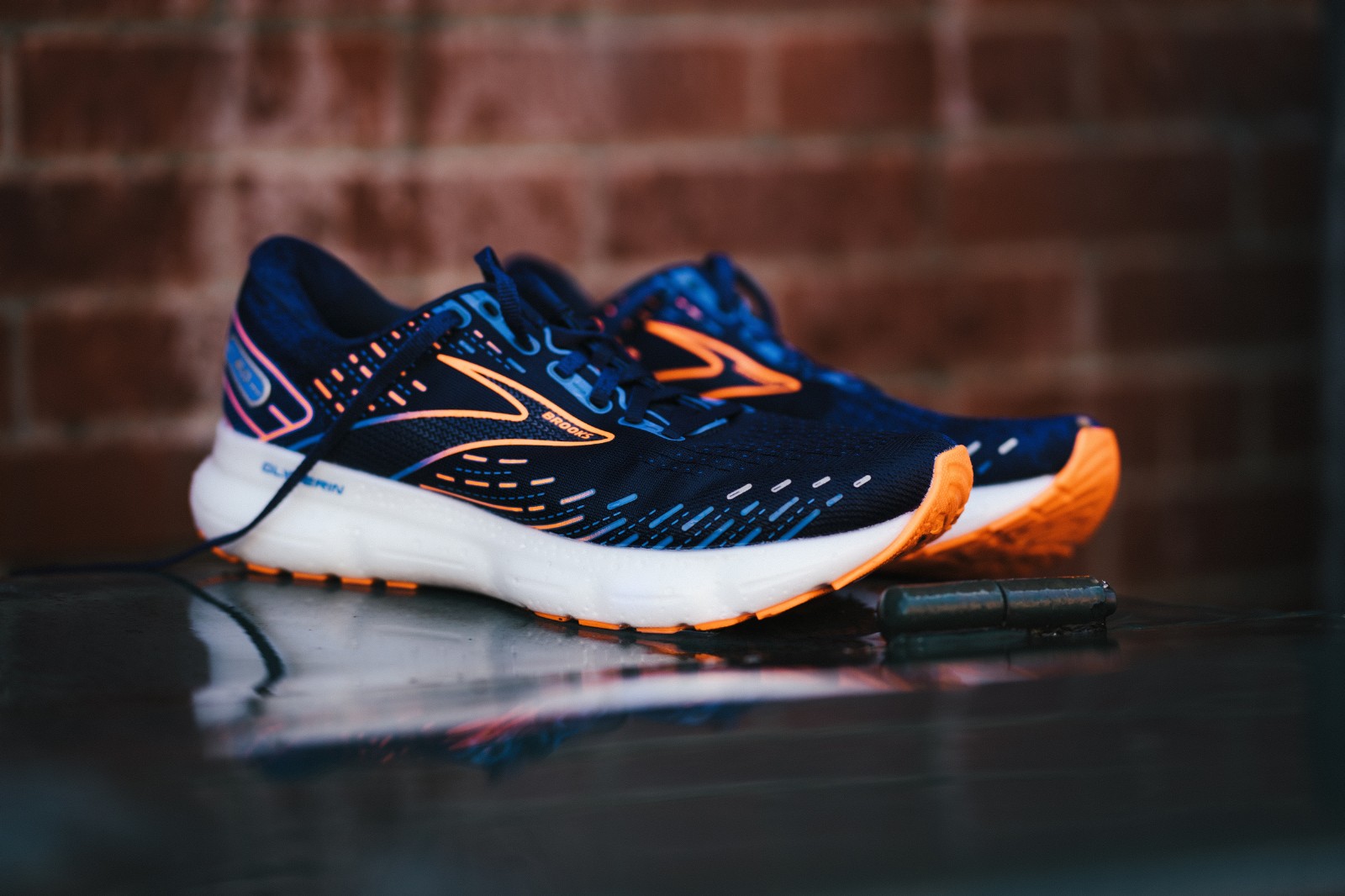
$150
Daily trainer
11.4 oz. (323 g) for a US M10.5 2E Glycerin 20
11.7 oz. (331 g) for a US M10.5 2E Glycerin GTS 20
38 mm heel, 28 mm forefoot (10 mm drop)
I’m officially combining 2 shoes into 1 review here in the wide foot roundup. The Brooks Glycerin 20 and Glycerin GTS 20 are just about the same exact shoe, except the GTS (Go-To-Support) has Brooks’ GuideRails for stability.
For the upper, both shoes have the same engineered mesh. It’s soft in the toe box and plush around the heel collar. The wide fit is good. It’s not an overly spacious toe box or midfoot, but gives a nice secure fit.
Both shoes feature a DNA LOFT v3 midsole. Brooks’ website pushes it as “supreme softness” and describes the shoes as super cushioned. I’m not sure who was in charge of describing these shoes, but to me it seems flat out wrong. I don’t really get much cushion or that plush underfoot feeling.
While running, the GTS feels slightly more stable and firm because of the GuideRails, but it’s not like the regular Glycerin is an unstable shoe. Both shoes did start breaking in after a handful of miles, but they never felt soft. I thought both shoes skewed to the firmer side.
I used them for easy everyday miles. I didn’t opt for faster days because I wasn’t getting much responsiveness, and I didn’t want my legs beat up on the long runs. I appreciated them as daily trainers, even though they didn’t excel in any specific area. I also used both shoes for our neighborhood walks and they are good for that too.
The Brooks Glycerin 20 and Glycerin GTS 20 are solid shoes. Whether you’re looking for a neutral daily trainer, or need some added stability, Brooks has you covered. I don’t strongly dislike anything about them, but I don’t love anything either. It’s rather obvious that Brooks fans will be content, and in the end isn’t that all that really matters?
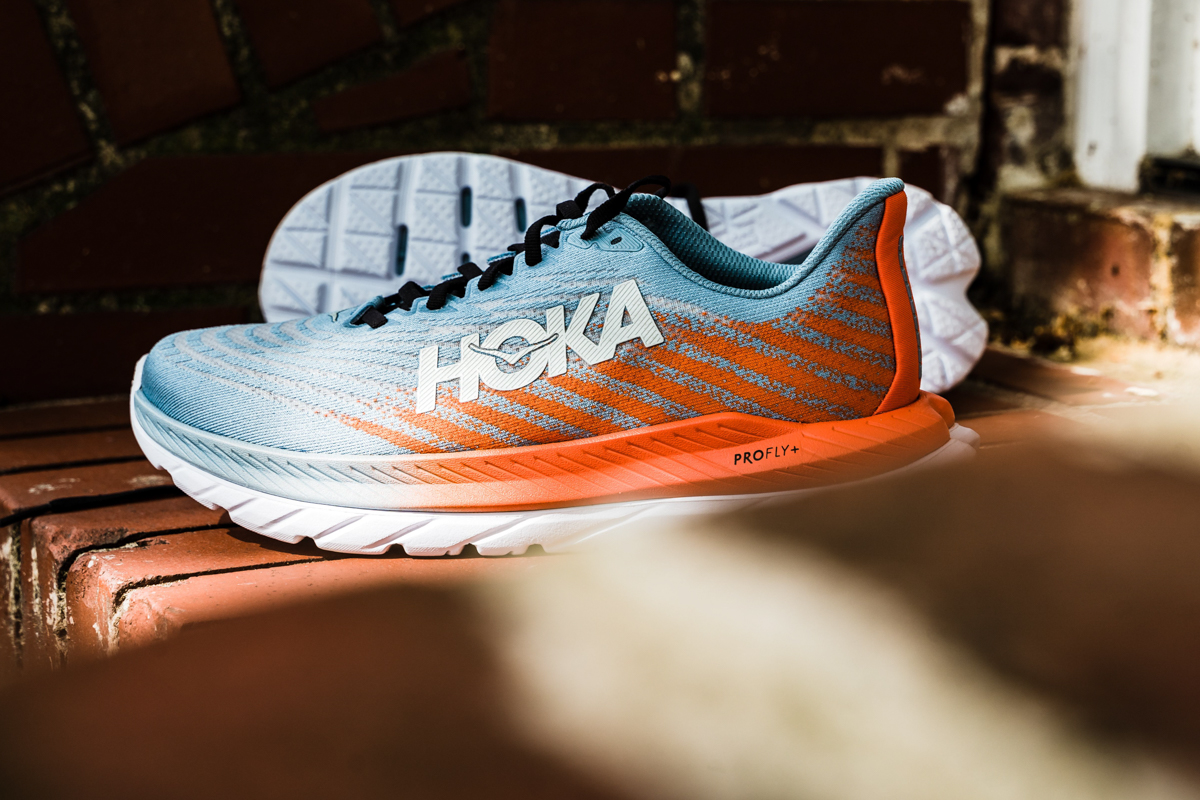
$140
Daily trainer/tempo
8.7 oz. (246 g) for a US M10.5 2E
29 mm heel, 24 mm forefoot (5 mm drop)
It has only taken 5 iterations of the Mach and a offshoot Supersonic to get Hoka to spread the love to the #WideFootFam. The Mach 5 is a lightweight daily trainer that can be used for tempo work and even race day.
The upper is a jacquard mesh that is light and breathable. It sports a super thin, lay-flat, gusseted tongue, and a plush heel collar. I’ve had issues with wide Hoka shoes in the past being too narrow which caused pain and discomfort. I found the Mach 5 wide width to be just enough for my midfoot. It’s a little tight, but causes no irritation.
The forefoot also has enough room for me. I get a solid lockdown without any heel slip. The biggest issue I have with the upper is how short the tongue is. When the shoes are tied, I can barely grab the tongue. The guessetting thankfully keeps the tongue from moving around, otherwise it would be a disaster.
The Mach 5 has a dual density midsole. The upper layer features the ProFly+ foam, while the bottom is a denser layer of rubberized EVA foam. I’m loving the underfoot feel while running. It gives a light and nimble ride that has a snappy bounce to it. I’m not sure I would pick the shoe out for a recovery day, but damn it runs well at an easy and moderate pace. Also, with the wide base, it feels very stable.
I’ve definitely got some concerns with the durability, as the outsole is that rubberized EVA. The traction was great in both dry and wet conditions, but my pair has some wear and I haven’t even reached 50 miles yet.
If you’re looking for a lightweight daily trainer that can easily be used for faster miles, the Hoka Mach 5 just might be the shoe you seek.
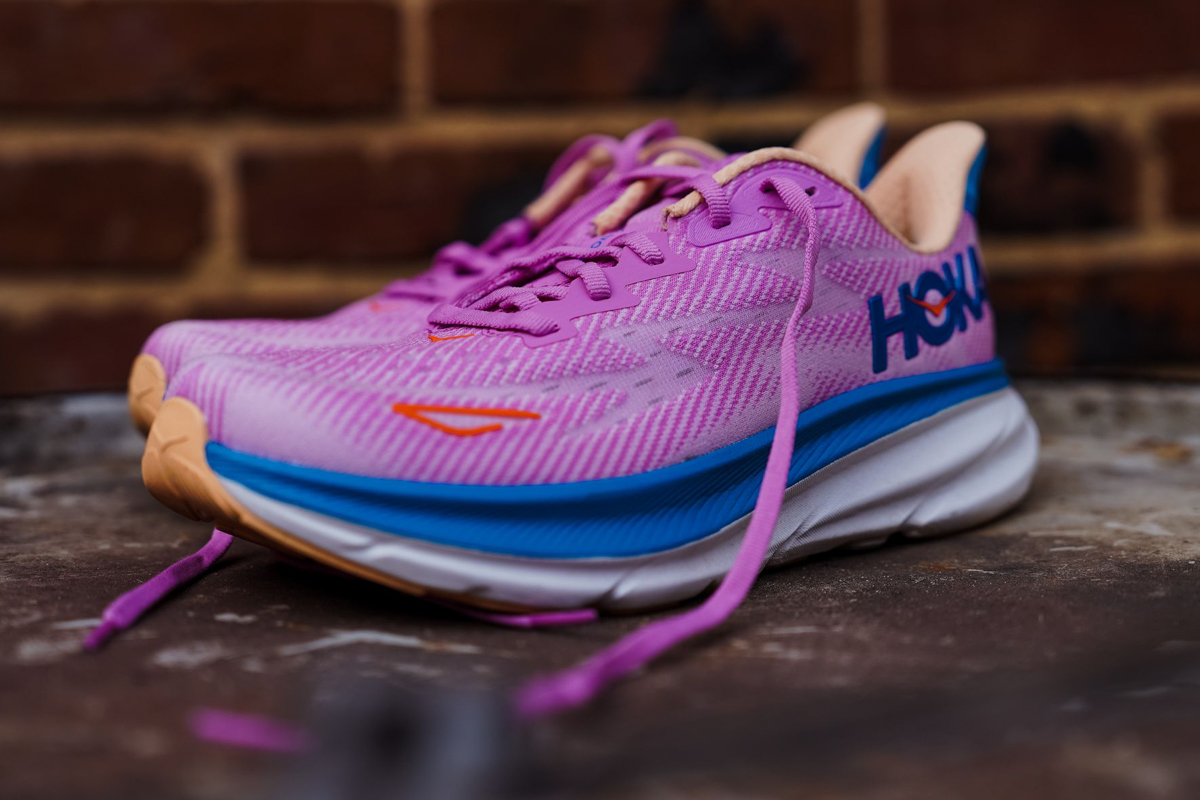
$145
Daily trainer
10 oz. (256 g) for a US M10.5 2E
32 mm heel, 27 mm forefoot (5 mm drop)
The Mach 5 was the first indication that Hoka was truly committed to the #widefootfam, so I was super happy to see some extra side space come into the Clifton. In the past, Hoka’s wide models were wide only by volume; the actual platform seemed to be in the same narrow range that Hoka has always been known for.
But that seems to have changed this time around. Which is good, because as Hoka’s most iconic trainer, the Clifton is a great shoe for everything you need on your run, providing comfortable and reliable daily training miles.
With a new formula of Profly EVA, it does indeed seem softer and bouncier, while keeping the shoe relatively lightweight. While I wouldn’t take this out for speedwork (save that for the Mach 5), I would take this out for just about everything else.
Point being– this may be one of the better wide foot shoes out there, and you if you’re reading this list, you can now find a comfortable seat on the Hoka wagon.
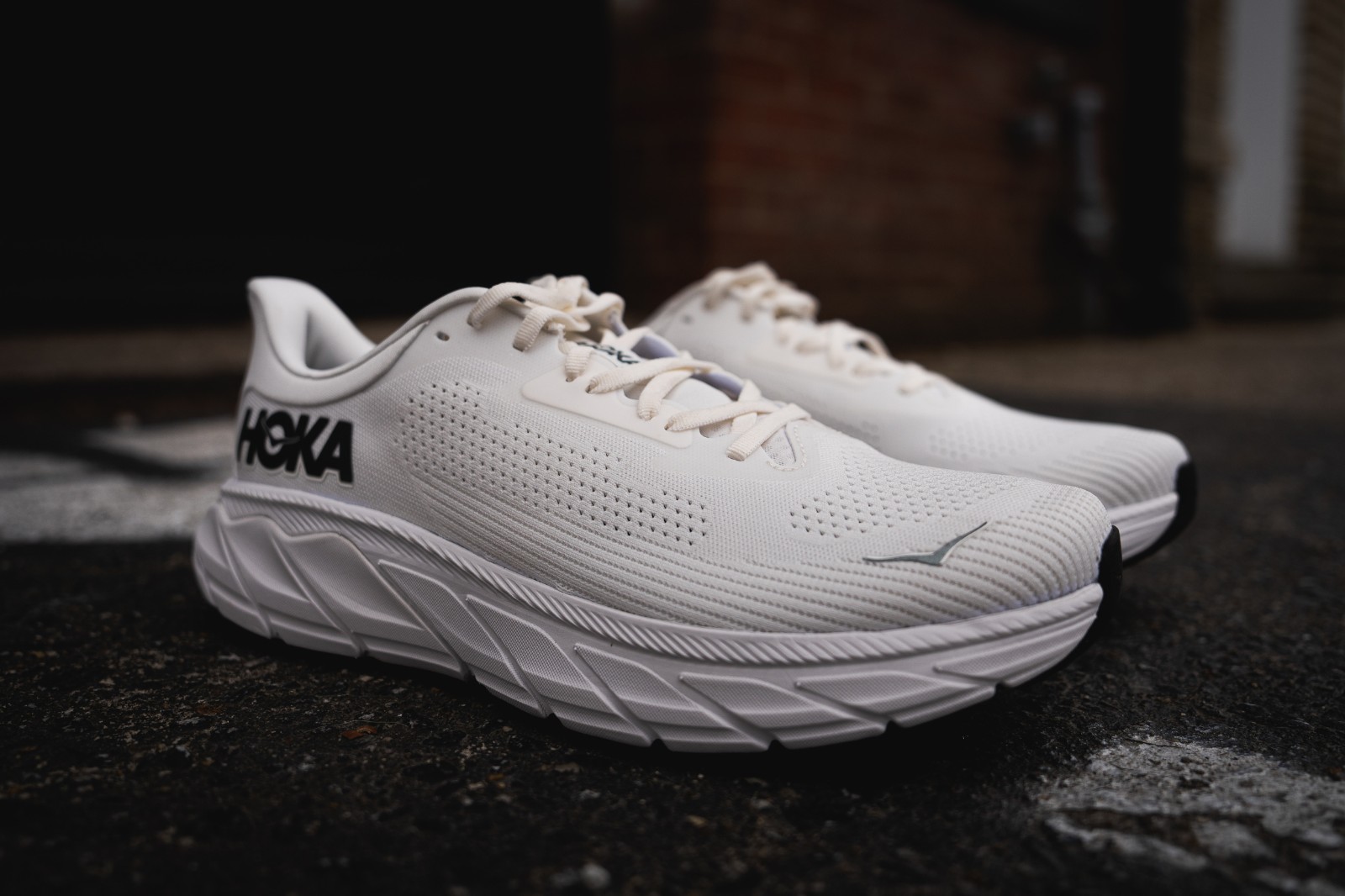
$145
Daily trainer, stability
10.2 oz (289 g) for a US M10.5 2E
37 mm heel, 32 mm forefoot (5 mm drop)
Yes, this is a “best of” list. But I feel like I need to include the Arahi 7, just in case you ignore all my other advice and try to buy it on account of Hoka’s current cool factor. I’m going to start off with the best thing about the Arahi 7, and that is the all-white colorway I got. It’s so clean and I really like that brands are flipping the script and putting out wide colorways in white as opposed to the all black, gray, or navy.
The only new changes to the Arahi are in the upper. It’s got a flat-knit upper, a plusher tongue, and a stretchy dual gusseted tongue to keep it from sliding around. I do think the upper feels nice and I appreciate the padded tongue and heel collar, but the shoe feels pretty tight in the midfoot in 2E. Hoka has been a brand that we all know fits slim, and that trend continues with the Arahi 7.
The midsole of the Arahi 7 remains the same as the 6, and features the J-Frame for midsole stability. The foam feels pretty firm and doesn’t have much life to it. When running, I felt like my feet were slapping the ground because there was no roll or good heel-to-toe transition. Sure, the shoe is very stable, but it doesn’t have to be stiff to have stability. There wasn’t much to look forward to when trying to get out for my morning miles. This is by far the worst version of the Arahi, which we’ve heard from pretty much every reviewer and is evidenced by the many one- and two-star reviews on its shop page.
I enjoyed using the Arahi 7 as a casual shoe, and that’s about it. The Arahi 7 is fine for walking, but I don’t plan on putting it back on for a run in the foreseeable future. Sorry, Hoka. I’m not even to include shop links because you shouldn’t buy it.

$165
Daily trainer/long run/recovery
10.5 oz (297 g) for a US M10.5 2E
38 mm in heel, 32 mm in forefoot (6 mm drop)
When I think of daily trainers, the New Balance 1080 is one that always comes to mind. Version 13 has seen some large updates with a new engineered mesh upper and a much softer Fresh Foam X midsole.
The engineered mesh upper is a nice welcome from v12’s Hypoknit which didn’t hold the foot as well. This new upper feels really nice on my foot and has no pressure points. Both the tongue and heel collar have enough padding for my liking.
The sizing has been fixed from the 1080v12, seeming to be very long. I went half a size down to a 10 2E in last year’s shoe, whereas my size 10.5 2E fits perfectly. I think a lot of people needing 2E wide will like the fit. The toe box is generous, but not massive and sloppy. I also think the midfoot has a good amount of space and my feet are rather happy with these shoes.
The Fresh Foam X midsole feels like it has a crazy amount of cushioning without being one of the max stack height shoes. It’s definitely softer than the v12. I loved how nice it felt when going out on easy day runs and I think my knees were thanking me for the cush. I didn’t think it had a big amount of rebound, so any time I tried picking up the pace it felt like it took a little more effort.
New Balance knocked it out of the park with the 1080v13. It’s an extremely comfortable and cushioned daily trainer. The traditional upper is also much nicer than the previous version’s Hypoknit. You want a shoe that can gobble up miles? The New Balance 1080v13 can easily fill the role.
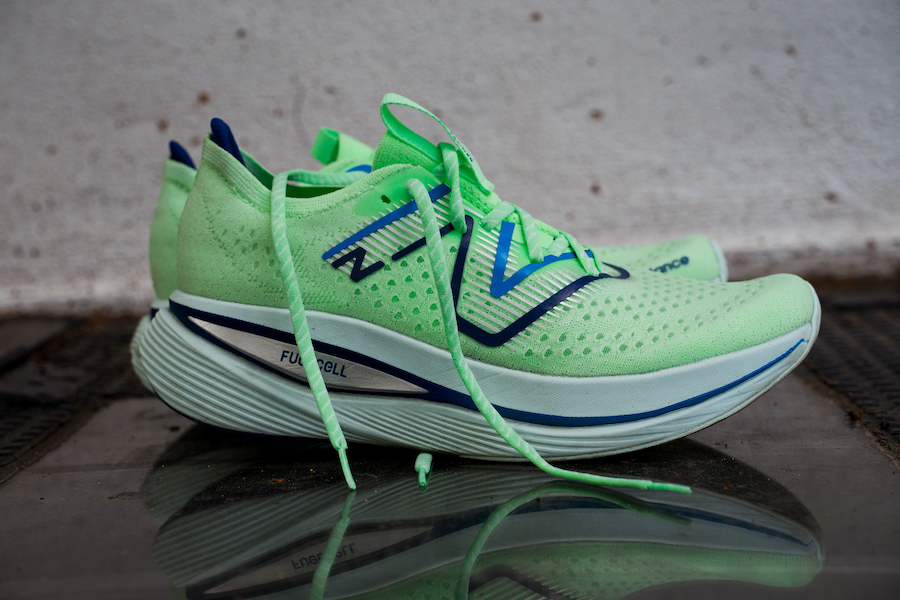
$180
Daily trainer/long run/recovery
11.5 oz. (326 g) for a US M10.5 2E
47 mm heel, 39 mm forefoot (8 mm drop)
Well, #WideFootFam, we’ve reached the light at the end of the tunnel. New Balance provided us a ticket to the ball in the form of the SuperComp Trainer. This carbon plated shoe review will be done using the WIDE option.
The upper is a nice lace knit material with a bit of stretch to it (not as extreme as the hypoknit). I tried on Thomas’ standard width pair over a month ago and thought it felt too tight in the midfoot. The extra upper material of the wide version makes the fit so much more comfortable. It may just be the best fitting plated shoe I’ve tried.
The midfoot is a little snug, but not tight, and the toe box has more space. Besides the lateral midfoot logo, there are no overlays to cause excessive pressure. The gusseted tongue is nice and I didn’t have any problems with the collar.
The SC Trainer is the evolution of the FuelCell TC. This go around, New Balance decided to blow past the legal World Athletics height limit of 40mm with 47mm of FuelCell goodness. A massive midsole doesn’t come without some extra weight. My pair weighed 11.5 oz. I’d be more upset if it was a racer, but this is for training, so weight isn’t the end all problem.
New Balance is touting their energy arc midsole technology, which contains a cambered carbon plate that’s sandwiched between two layers of FuelCell foam. The bottom layer contains a void going down the center of the entire length of the shoe. This allows the shoe to maximize energy return.
I was pretty concerned about how stable the shoe would be with the huge void. However, I’m pleasantly surprised to say it’s even more stable than the FuelCell TC and RC2. The width of the heel is a good amount wider than both those shoes and it helps with the pronating. Just keep in mind that this isn’t a stability shoe and if you pronate bad, you may have some issues. I was extremely hesitant when taking corners fast. I found it nearly impossible to avoid slowing down as I didn’t want to roll my ankles.
The midsole foam is absurd with how soft it is. It may just be the softest shoe I own. While people talk about the compression, I’m fairly confident the technical term would be “the squish.” In the SC Trainer, the squish factor is next level. Paired with the carbon plate, I get a soft landing that has excellent energy return to keep me moving.
My miles have been excellent. I had mile pickups with Thomas during a long run and other days I took it slow and easy. The shoe can perform at higher paces if needed, but shines on easier everyday running.
The more I run in the SC Trainer, the more I like it. Sure, the weight is up there, but this is a high performance trainer and is going to keep you feeling fresh on those long runs where you’re just going for distance. Oh, and did I mention it freaking comes in wide?! I’ve got a feeling the SC Trainer is going to get pulled off the shoe rack a lot. It’s a winner. Simple as that.

$110
Daily trainer
11.1 oz (314 g) for US M10.5 2E
31 mm heel, 25 mm forefoot (6 mm drop)
Forget all your prior opinions about the New Balance Propel. This year, the v4 may as well be a brand new shoe. The FuelCell midsole has been reformulated and is now softer and bouncier than v3. New Balance even took things one step further and introduced a TPU plate to the shoe.
For anyone who ran in the previous versions, v4 is noticeably softer and bouncier. The FuelCell midsole is the same formulation as the SC Trainer, and feels good at any pace. If you’d like to pick it up, the TPU plate will help give you some snap.
I don’t think the Propel v4 gives off the high propulsion and aggressive carbon plate feel you get from the fancy race day shoes, but guess what? At less than half the price, the TPU plate does the job just fine.
The mesh upper feels good and I don’t have any hot spots in it. The tongue is thinly padded and sits nicely on my ankle. I also like the heel padding and never had any heel slipping. My 2E pair feels good from the forefoot through the midfoot. If you’ve had success with the other wide options I’ve suggested, you’ll be happy with this as well.
I firmly believe the FuelCell Propel v4 is the best budget shoe on the market right now. If the weight would have come in under 10 oz., I’d probably lose my mind. The wide fit is great, the ride is nicely cushioned, and you could even use it as a race day option because of the TPU plate. All of this for a friendly price of $110? As Stone Cold Steve Austin would say; Give me a hell yeah!
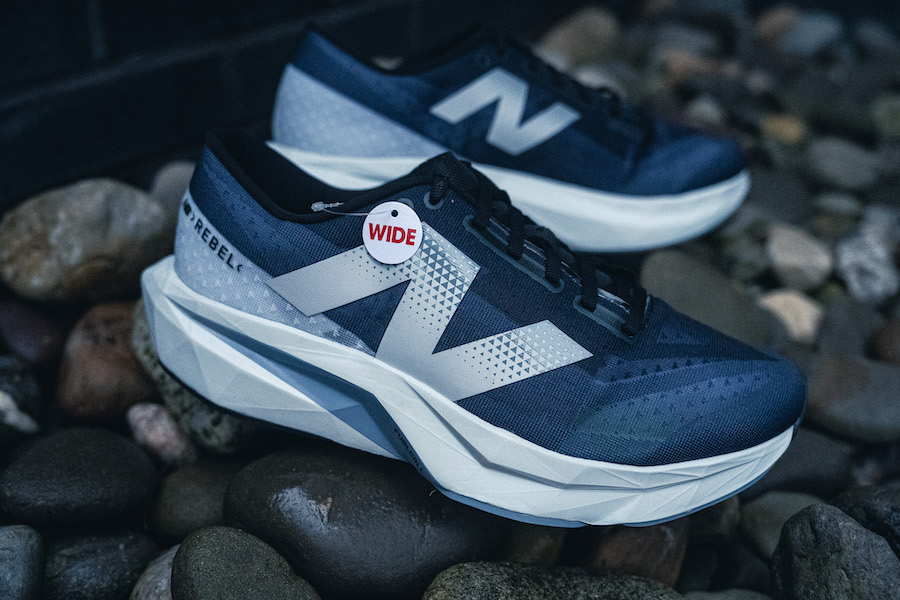
$140
Daily trainer/tempo
8.1 oz (229 g) for a US M10.5 2E
30 mm in heel, 24 mm in forefoot (6 mm drop)
The New Balance Rebel is back for a 4th time, and has received a large overhaul. The upper is a new Fantomfit mesh and the FuelCell midsole is a blend of Peba and EVA. Visually, the Rebel seems to have regained its roots and looks stunning. While v3 was a bland trainer, v4 has a large in your face N and strong angular molding in the midsole. It looks so slick.
New Balance calls the new mesh upper Fantomfit. It’s very soft and pliable without being overly stretchy. The thin gusseted tongue is just about the same as was in v3. I would like it to be slightly longer or more substantial as I can feel the laces on the top of my feet when I lace up my shoes tight. The heel collar has just enough padding to keep it comfortable on my Achilles.
The wide fit is very generous. I have to pull the laces pretty tight to get a secure lockdown and the toe box has a ton of room. However, with all the room, I don’t find the shoe to feel sloppy. I haven’t gotten any blisters nor do my feet slide around.
The Peba/EVA blended midsole allows it to be soft, bouncy, and light. Honestly, it doesn’t give as much bounce or give back as I’d like, but it feels really nice under foot. I was surprised at how smooth my stride felt while running. The midsole is very flexible and doesn’t feel stiff at all. I think the midsole is a very nice upgrade compared to the tamed Rebel v3.
The New Balance Rebel v4 is a great option for a wide uptempo trainer that is on the lighter side. It feels smooth and flexible, while providing a very nice amount of width in the 2E option. The design is also way better than v3 as it no longer looks like a cheap shoe. For those who liked the Rebel v3, I think you’re going to be very happy with v4. If you want a faster shoe without going to the carbon plate realm, check out the New Balance Rebel v4.
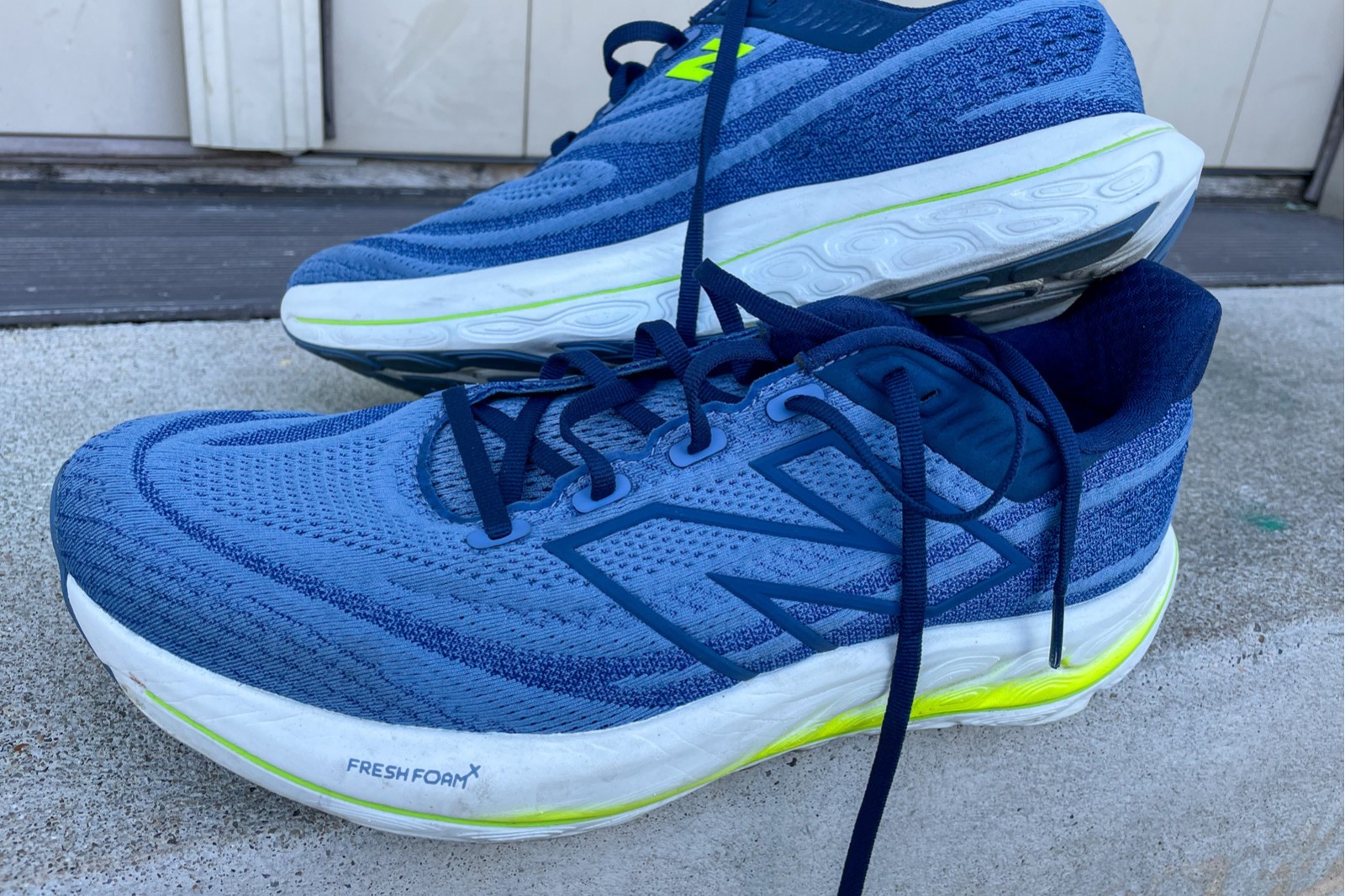
$165
Daily trainer, stability
12.1 oz (343 g) for a US M10.5 2E
38 mm in heel, 32 mm in forefoot (6 mm drop)
I can’t believe it has been over 2 years since the release of the New Balance Fresh Foam Vongo v5. I adored that shoe and went through 3 pairs. The wait is finally over and New Balance has pulled out a pretty big update with the Vongo v6 that is worthy of your attention.
New Balance ditched the Hypoknit upper for an engineered mesh. It’s no longer the overly stretchy mesh that can be a little sloppy. I would go so far as to say the new upper is luxurious. It’s padded nicely around the heel and the tongue, it fits great, and is soft to the touch.
As for the 2E wide fit, I have no problems. The midfoot feels secure and snug, but not tight. The forefoot lacks any overlays so I don’t get pressure points. New Balance tends to get the wide fit right, and the Vongo v6 is no exception.
The midsole is made up of Fresh Foam X. I think it feels softer than the previous iteration, while also providing a more comfortable and smoother ride. I wouldn’t go so far as to say the midsole is soft, but it has some nice cushion to it that a lot of stability shoes don’t have. On my easy and no-pace runs, I really enjoyed running in the Vongo v6. That being said, I never felt like I could pick up the pace well, but I have other shoes for tempo work and race day.
No longer is a medial post used to create stability within the shoe. This time, New Balance has added a EVA plate within the midsole that is lower on the lateral side and higher on the medial side. It isn’t noticeable and doesn’t make it anywhere as stiff as a carbon plated shoe. I thought the plate worked well and I didn’t feel like my ankles were rolling in.
I’ve always thought of the 860 as New Balance’s heavy stability shoe, but this time the Vongo is the chunkier option. My 10.5 2E weighs 12.1 oz. Even though I find the 860v13 to feel slower, it’s still quite a move in the wrong direction from my wide v5s weighing 11 oz.
New Balance took their time bringing the Vongo v6 to market, and provided the stability runners with some nice new technology. The wait was worth it as this is a great daily trainer and extremely comfortable on foot. The biggest gripe I have is the weight gain, but no one is looking at a stability shoe and expecting it to be in the featherweight class.
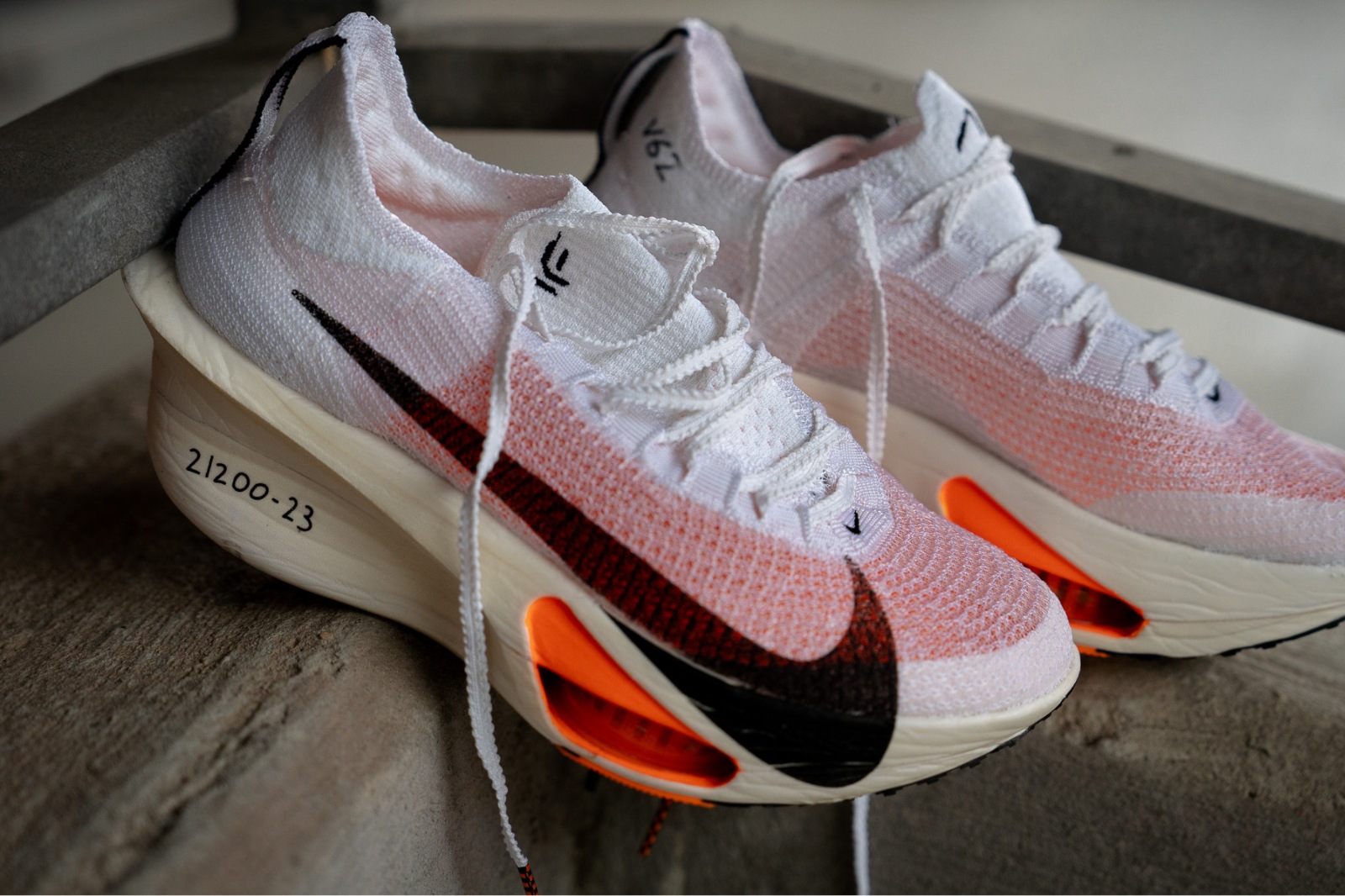
$285
Race day
7.8 oz (221 g) for a US M10.5 (standard width)
40 mm in heel, 32 mm in forefoot (8 mm drop)
I feel like there needs to be a preface with this shoe being on the wide foot roundup. For the past few years, I’ve had so many people asking if I have tried the Alphafly, and the answer was always no. I pulled a rabbit out of a hat and managed to get my grubby fingers on a pair of the Alphafly 3.
I can’t say that the Alphafly 3 will work for a lot of you in the #widefootfam as there are some other race day standard width shoes that are more accommodating. I imagine the Alphafly 3 is for the wide foot runners who don’t care about money and are willing to spend whatever to wear some of the best shoes out there. It’s for those who want the swoosh on their feet and are willing to do anything and everything possible, even if dumb and potentially injury inducing, for the opportunity.
The Atomknit upper is somehow see-through and also incredibly strong without being stiff. I can confirm how strong it is because I didn’t break the material with all the muffin-topping going on. It feels like I’m wearing very tight socks. I didn’t need to pull the laces tight to get a good lockdown, and I never experienced them coming untied nor any pressure on the top of my feet. Even without heel lock lacing, which I do on nearly every shoe I have, I didn’t experience any heel slip.
I wouldn’t say the toe box is as narrow as older Nikes, but it’s by no means wide. I had just enough space to not have any toe or bunion problems. The midfoot is where it feels tight to me. My arch was hanging over, although I didn’t get that stabbing feeling when I tried on a very old pair of Thomas’ original Alphafly years ago for 2 minutes. The lateral side of my midfoot obviously is bulging over, but the outsole doesn’t curve up and stab into my foot. The upper just feels very tight.
The midsole is made up of ZoomX that continues through the whole shoe without any weird decoupled gaps. The forefoot contains the two magical Air Zoom pods and there is a full length carbon plate. I am not exaggerating when I say my legs felt like they were kicking back while running at a faster pace. There was a beautiful feeling of bouncy pop and smooth transitions.
My longest run was 10 miles, and it reached a point towards the end where I was getting pretty uncomfortable, bordering on pain territory. My brain was having so much fun, but my feet were wondering why they were dressed in a corset.
It’s rather shocking to see Nike here, but I’m doing this in the name of science! I won’t be wearing the Alphafly 3 for a marathon, and if you’re here too, you most likely won’t either. It’s by no means a wide comfortable shoe. However, it’s the real freakin’ deal, and so long as I’m not getting injured, it’s pure enjoyment. I feel so fast and I can fly with the Air Zoom units, carbon plate, and ZoomX all working perfectly in tandem. I’d be willing to lace up the Alphafly 3 for a race 10 miles or less, while making a decision tree trying to see if the benefits outweigh my potential demise for a half marathon.
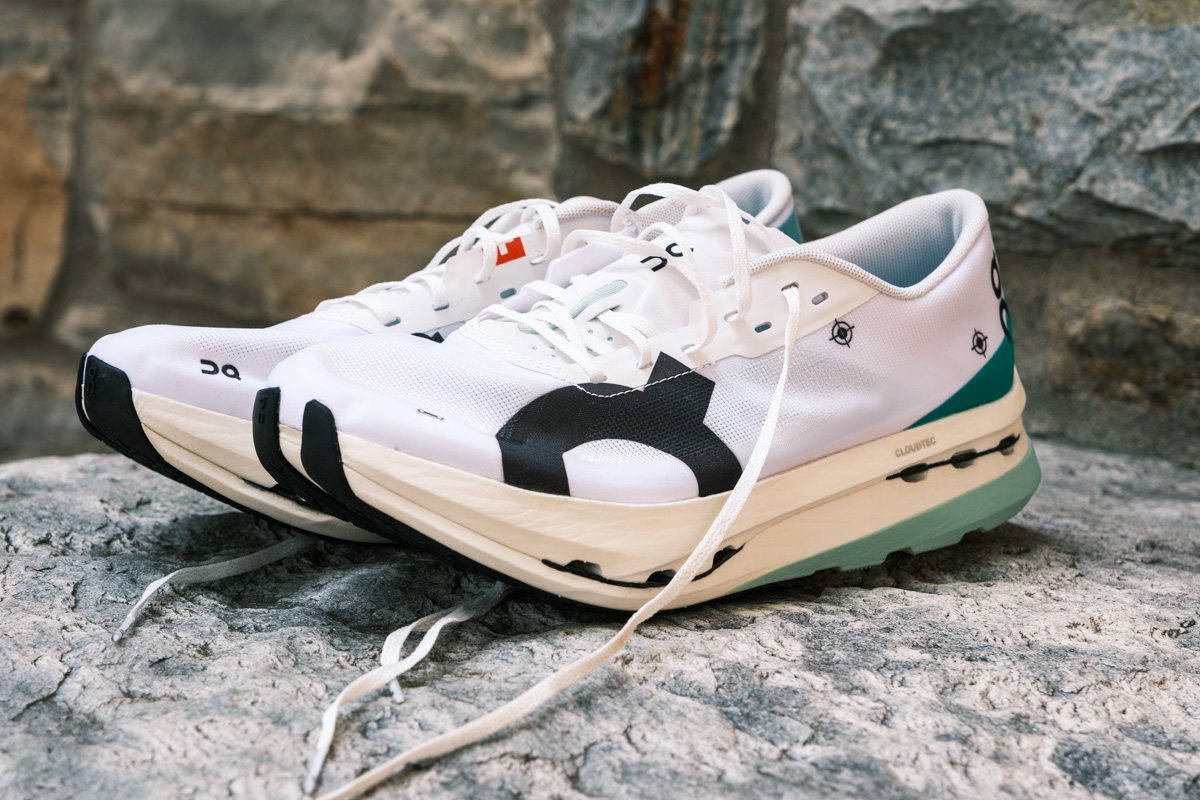
$290
Race day
7.5 oz. (215 g) for a US M8.5,
6.6 oz. (188 g) for a US W7.5
37 mm in heel, 27.5 mm in forefoot (9.5 mm drop)
There’s no denying that On has some of the best looking running shoes out there. They have a clean and rich look to them and On continues the trend in the race day Cloudboom Echo 3. It has an unfinished prototype color proofing look to it that is unique and I actually love.
The Cloudboom Echo 3 has all the looks of a narrow shoe and I had no faith in the fit for my chonky feet. The upper is a breathable microfiber material that feels very thin, but is surprisingly strong. On foot, the shoe feels on the tighter side in the midfoot and forefoot. I wore thin socks, which seemed to help, but on longer runs my foot was swelling and it felt even tighter. The upper lacks overlays on the lateral side of the shoe so my midfoot was able to push out and the platform doesn’t curve up so I didn’t feel like anything was digging into my feet.
The heel collar has a tiny bit of padding and thåe gusseted tongue is paper thin. My size 10.5 came in at 8.6 oz., which is slightly on the higher end for race day shoes.
On presents the Cloudmonster as their max cushioned… monster. The midsole is a softer Helion foam with larger CloudTec pods compared to other On models. Above the midsole is the familiar On Speedboard (a TPU plate). I have to say, the Cloudmonster does have a nice soft landing with a very smooth transition through the toe-off. My stride felt great and instead of stomping, I was rolling right through my stride. Underneath each pod is a dab of rubber for the outsole and the traction is solid.
The Cloudmonster may be a max cushioned shoe per On standards, but to be completely honest I find it to fit better into the daily trainer category. The landing is soft, but there’s not a super cushioned underfoot feel when landing because of the Speedboard. Don’t worry though, it doesn’t feel at all like you’re running on a piece of wood strapped to your foot like with some of On’s other options. Hopefully this makes sense and I’m not completely contradicting myself.
I took the Cloudmonster on a variety of runs and enjoyed all of them. Since I know the #WideFootFam is reading this, my 10 mile run in wet conditions saw no pain nor blisters. I was able to pick up the pace if I really tried, but it feels way better at a more relaxed pace. On has something here with the Cloudmonster. It’s unlike any of their other shoes and is definitely a winner. If I was using it solely as a max cushion recovery shoe, I may be a tad disappointed, but thinking of it as a daily trainer has me very pleased and impressed.
Note: wide sizes seem to be scarce right now, so you may have to dig a little deep to find a pair.
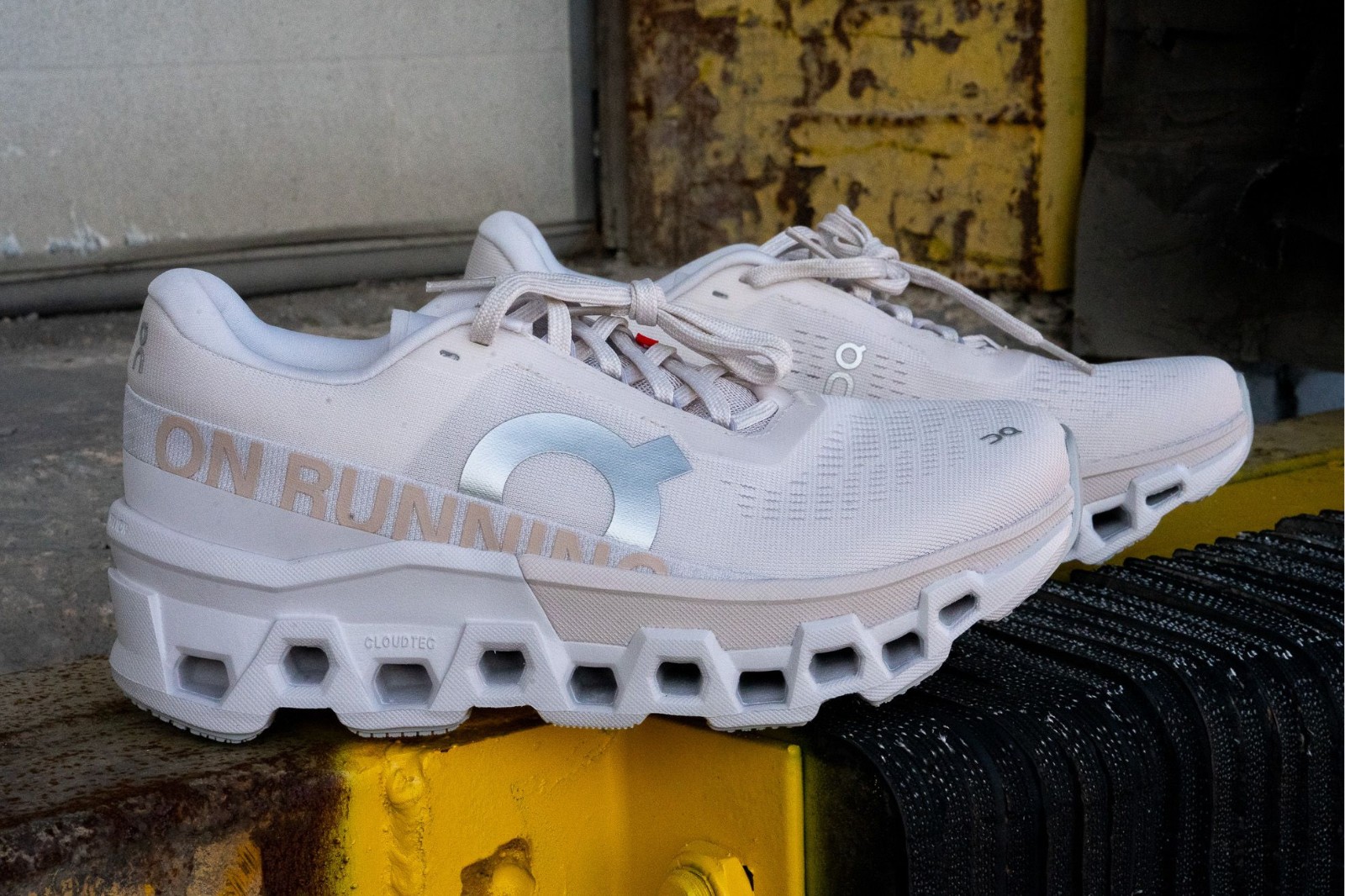
$180
Daily trainer, neutral
10.9 oz (309 g) for a US M10.5 (standard width)
39 mm heel, 33 mm forefoot (6 mm drop)
I was a fan of the first Cloudmonster and was ecstatic about how accommodating it was. I had hoped On wouldn’t make it tighter, and my wish was granted … kind of.
The upper is pretty much the same, except On updated how the laces are held by adding a fourth loop. The 100% recycled polyester upper feels very soft and I love the heel collar and how comfortable it is.
However, the sizing of the Cloudmonster 2 is a little off. My pair runs a bit longer than my previous pair of the original Cloudmonster in the same size. As shocking as it sounds, the upper is a bit baggier too. This is easily the most accommodating On shoe, which means standard width people may have some lockdown issues (indeed, our standard width reviewers did). I thought it would be a good idea to do a 16-mile run out of the box and I got a blister where a bunion would be because my foot was sliding some.
On states the Speedboard has been updated with a nylon blend sandwiched between a dual-density Helion superfoam midsole. This supposedly makes the landings softer and increases the energy return. I thought the first Cloudmonster was relatively firm for being a max cushioned shoe, and I feel this way again with the Cloudmonster 2. It may be a touch bouncier, but there isn’t a drastic difference in my opinion.
The outsole hasn’t changed and provides a nice grip. My size 10.5 standard width weighs 10.9 oz., up from my old pair weighing 10.3 oz. The additional midsole foam and extra length is pushing the weight in the wrong direction.
The On fans with wider feet are going to be happy that the Cloudmonster line continues to have lots of space. For me, it’s tough to want to continue running in the Cloudmonster 2 because of the length and lockdown issues I have. I think if you could get a good fit, the shoe would be a nice daily trainer with a responsive ride compared to On’s Cloudeclipse. I love how it looks, so at least I can rock it out on the town in style.

$160
Daily trainer
9.5 oz. (269g) for a US M10.5 2E
35 mm heel, 27 mm forefoot (8 mm drop)
The Ride 16 is the flagship daily trainer for Saucony. I was a fan of last year’s version, and this year is no different. Part of that reason is because the shoe is almost no different. The Ride 16 has the same PWRRUN midsole, while the upper has been tweaked ever so slightly.
The fit of the wide is solid, without being overly tight or excessively baggy. I don’t have any problems with the midfoot or forefoot. The updated upper has a new tilley system (whatever that means) to help with the lockdown, although I didn’t really notice any difference from the 15 while running. I will say, I love my burnt orange wide colorway and I think it looks miles better than my previous pair.
I’ve noticed that the PWRRUN midsole tends to skew towards the firmer side. It doesn’t provide much cushion or bounce, but is relatively smooth through stride. With great firmness comes great stability, and although the Ride 16 is a neutral shoe, I don’t think pronators would have much problem.
As much as I’d like the Ride 16 to be a little softer, Saucony offers so many other options for that preference. The Ride 16 is a pretty standard daily trainer that doesn’t take any chances to mess up the legacy.
For those who want to move on and get the newest model, don’t expect any surprises. Otherwise, save a few bucks and snatch up the remaining Ride 15 as they are extremely similar.

$150
Daily trainer/tempo shoe
7.4 oz. (209 g) for a US M10.5 (standard width)
28 mm heel, 23 mm forefoot (5 mm drop)
The diehard Topo fans will be more than pleased to know that the Cyclone 2 has changed my mind about Topo and I may be the newest convert.
The Cyclone 2 features a 100% Pebax midsole. This allows the shoe to provide a bouncy and responsive ride, while keeping it super light. My 10.5 weighs just 7.4 oz. (209 grams). With a 5mm drop (28mm heel and 23mm toe), I never had to wean my way in like people suggest with 0mm drops.
This shoe is meant to be an uptempo trainer, and I completely agree. Sure, my slower easy miles were nice and I felt the softness of the Pebax, but the shoes felt great when picking up the paces. I felt like the shoes came alive and I was moving with relative ease.
The tightly woven upper is light and thin. The midfoot had a nice snug fit and the toe box was exceptionally spacious. I didn’t feel like my toes were cramped, nor were they sliding around. This is for sure an approved #WideFootFam fit.
The tongue is padded and has 2 lace pass throughs to keep it from sliding around. The heel is also nicely padded and feels great around the ankle. People who had issues with the Cyclone 1 heel collar will be happy with the update.
Underneath is a thin rubber covering the forefoot and heel, with exposed Pebax midsole in the midfoot. I thought the traction was good on the road in dry conditions. On the 2 wet runs, I was a little more hesitant when taking corners. Obviously the exposed midsole was to save weight, although it has me wondering about the life expectancy. It’s not a concern right now, but I do have some (hopefully just) cosmetic wear after 40 miles.
Lastly, I like how these look. Topo does a good job making the roomy toe box design look sleek and fast. However, there’s no denying these look pretty pretty similar to the New Balance Rebel v2…
It’s a bummer the Cyclone has jumped from $120 to $150, but that’s obviously because of the full Pebax midsole. I guess I’m so used to seeing prices bump about $10 (i.e. the 2022 inflation tax), so the $30 was a bit jarring. With great Pebax comes great costs. In this case, it’s worth it.
I may not have tried all the offerings from Topo, or even the recent ones, but I would still bet that the Cyclone 2 is the best shoe that Topo has released. The Cyclone 2’s fit is nice and locked down in the midfoot and the toebox is roomy and very accommodating. The star of the shoe is the Pebax midsole which gives a fun and fast ride. Plus, at 7.4 oz. for my size 10.5, this is one of the lightest wide fitting shoes I own.
Shop Topo AthleticTrail Running
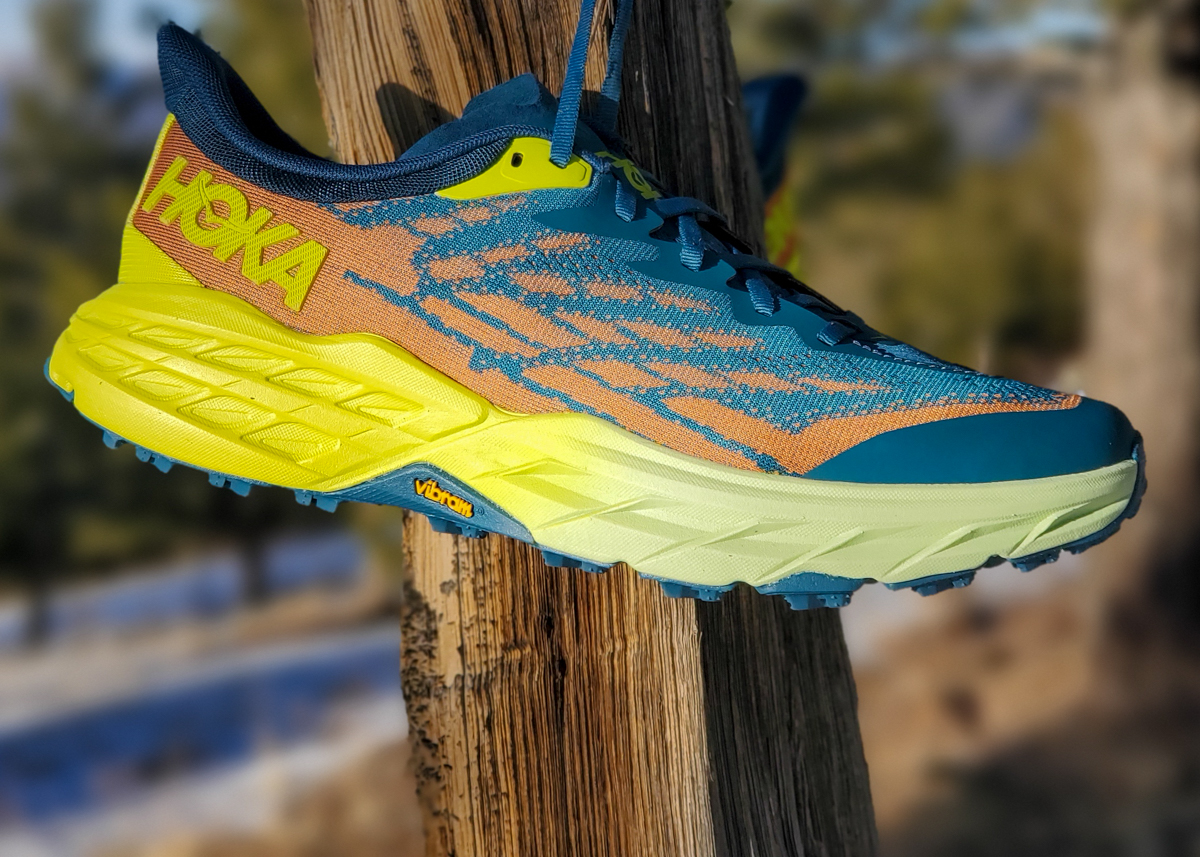
$155
Do-anything trail shoe
10.3 oz. (291 g.) for a US M9
38 mm heel, 34 mm forefoot (4 mm drop)
The Speedgoat is usually in the conversation when trail shoes get talked about. It’s a shoe I was never able to wear because of the standard width, so I got pretty jazzed when I saw it was finally coming in wide. Spoiler alert: the width is great!
The EVA midsole cushion is impressive, and I didn’t feel rocks or sticks while on the trails. This is usually a worry because I’ve gotten a super gnarly bruised heel before, which kept me from running for a week. I will say the Speedgoat did feel a bit unstable because of the lack of ground feel.
If I were to buy another pair, I’d probably size down half a size. Between the super-thin tongue, weirdly obnoxious overlay right above the middle of the toe box, and struggle to get a good tight fit, I ended my runs with a few blisters. I think a lot of that probably came from my feet sliding forward at times.
The Vibram MegaGrip outsole provided some super solid traction while running down the trails, around switchbacks, and over wet rocks.
Our standard width reviewers love this shoe more than almost any other trail shoe because of its versatility on any terrain, whether that’s in an ultramarathon or a three-mile Saturday hike. There’s a reason it’s a legend in the trail scene.
There aren’t too many trail options that come in wide. Hoka throwing the Speedgoat into the 2E ring is a game changer!
Want to learn more about how our review process works? Check out this guide.
Have something to say? Leave a Comment

Wide Foot Jarrett likes talking about wide shoes. Did you know he wears wide shoes? You should probably know he wears wide shoes. Besides running, Jarrett is a lover of coffee, donuts, pizza, and tacos. Basically, Jarrett is the ultimate race-cation travel companion because he will be on food duty while you’re busy panicking about whether you want to try and break your PR. Will also sleep on the floor. He’ll also answer any question in his DMs.
All-time favorite shoes: New Balance Vazee Prism v2, New Balance FuelCell SC Trainer, Asics Metaspeed Sky.
More from Jarrett Read Article
Read Article
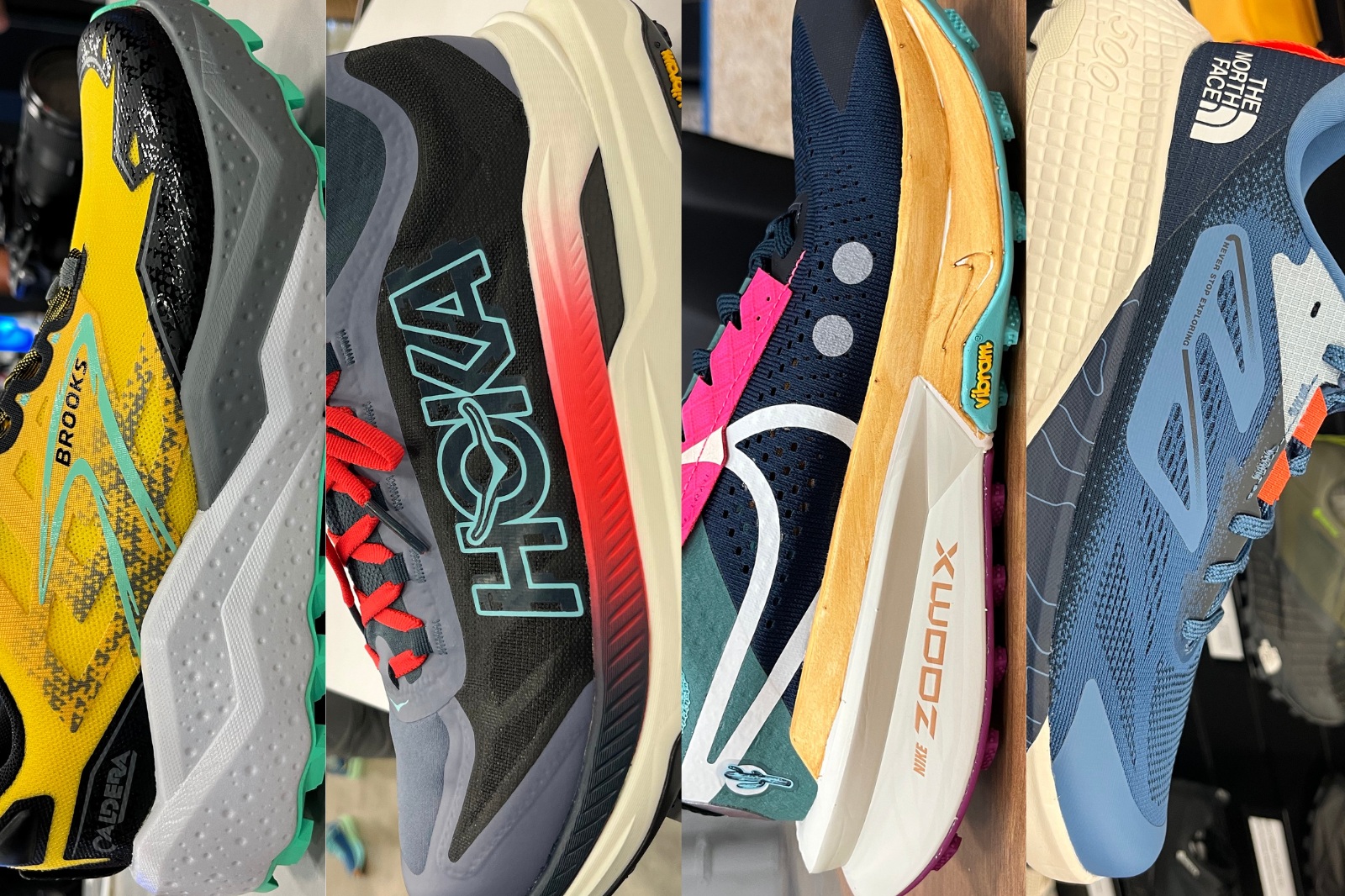
 Read Article
Read Article

How can you do a wide shoe review without even mentioning Altra, the guys who pretty much invented wide feet? 🤔 🤷
Despite popular belief, Altra aren’t wide shoes, they just have more room in the toe box. We’re reviewing the wide version of the Lone Peak right now, and in the past enjoyed the wide version of the Torin.
Joe Nimble should be another option, wide shaped shoe lasts for over 40 years now, proven at the Badwater several times (first Badwater runner to ever finish in one single pair only from start to finish). joe-nimble.com
I saw a post on reddit. It said almost every wide(2e) shoes have the same footbed width with the standard versions. Manufacturers don’t adjust midsole platform width, but they just increase upper volume due to the cost.
Is it true? May I ask your opinions or experiences about it?
could You review Altras.
Some of us use wide due to wide toe box basically.
I had the Altra Paradigm, and they fit great, in regular D size, due to the wide toe box.
I recently tried to altra lone peak 7 in wide. I really loved the fit (no blisters or sore feet) and it is an awesome trail shoe, but I had some serious slipping problems in wet and messy conditions.
Altra (standard width) and Topo are fantastic options if you need a wide toe box but a normal midfoot. Altra now differentiates the standard width and wide, and havent had the opportunity to try more of their shoes. It’s tough trying to get through everything!
Doing a wide shoe review with a 2E foot is not serious. I wear a 4E-6E(when I can find them) and most of these shoes are not built wide enough to accommodate my foot. Altra may be fine for a slightly wider than average foot, but they aren’t even close for those of us with really wide feet. The Asics Nimbus line (4E) is the one I have used in the past, but the 24s somehow were not as wide as previous versions. Any insights on the 25s?
Is there a wide shoe with both a good collar and a WIDE HEEL? You don’t comment on heel width that I can see. My ASICS Gel Nimbus 25 is too narrow in the heel for me.
Thanks for convincing me that Sauconys can work for people with wide feet! I am loving the Triumph 20 and Endorphin Speed 3, both in 2E, for training, and the Endorphin Pro 3 in regular width for racing. You’re providing such a valuable service for those of us who are part-Yeti.
4E,
for hobbit feet?
clifton and match hoka,
have narrow fit.
Hi Jarrett – Just want to say thank you for all of your reviews and thoughts for all the #WideFootFam out there! I was wondering if you had a chance to try the New Balance Propel v4? I have really enjoyed them as a daily trainer and at $109 (I got mine for about $98 with a coupon code), you can’t really beat the value, IMO. For me personally, this is the best 2E daily trainer that I have used in my whole 2 years of running, haha. I am also looking forward to the SC trainer v2 (would love to get your thoughts, if you can get your hands on a pair). I am thinking about making a two shoe rotation with those and the Propel v4.
Hi! I’m in the camp needing extra wide, probably 3-4E, and the options are limited. Especially if you want a light shoe for fast workouts or racing. Any advice on this? I run in the wide version Altras, Lone peak and Torin, and despite being a little to narrow in the midfoot they work because of the wide toe box. Both are heavy shoes though. Am I missing any shoes on the market that might be a good racer or fast trainer for me? Also, are you in a position to influence the shoe makers towards making x-wide fast shoes?
Great reviews. Do you have recommendations for a running shoe that specializes in a wide midfoot area? Think rectangular shape foot. New Balances just don’t work for me. The barefoot shoes are terrible and make me trip over my own feet. Hoka fits in toe box but the midfoot area is way too narrow. I would spend $500+ on a shoe that fits.
I’ve been running in the NB 1080v12 wides (2E) for several years now. Just switched over to the Hoka Mach 5 wides. Enjoying the Mach 5s. Lightweight and very responsive. Also more breathable than the 1080v12s. I live in Hawaii so breathable shoes are a must. I have no arches (flat feet). Basically that rectangular shape foot you mentioned. Anyways maybe try the Hoka Mach5s. Just waiting for Hoka to release a wide version of the Mach X.
Nimbus 25 is has a narrower fit than the Pegasus 40. Nimbus 25 2E is like standard width. Saucony Endorphin series also have narrow fit and so does Hoka. This is a very misleading article.
Some really useful info. Thanks for keeping it updated, as I have this page bookmarked. Dare I mention that Mizuno have 2e sizes also. I’d be interested in your review of them. At the moment I have tried Hoka Rincon 3 2e – gave pain on the outside edge of my feet (not wide enough?). Saucony Ride 14 2e – made my feet numb after about 7-8k. Brooks Adrenalin GTS 2e – gave me callouses and blisters in forefoot and toes. NB 880 v12 2e – weirdly not long enough (and not a fun shoe to run in), whereas the NB1080 v11 2e were absolutely fine and I’ll be going back to them (if I can find the v12 or 13 cheap – I find the latest shoes a bit on the expensive side for me). I’d like t try the Adidas range, but have found that their normal / fashion trainers run narrow for me anyway and they are difficult to fin in 2e sizes at a price I can afford in the UK/